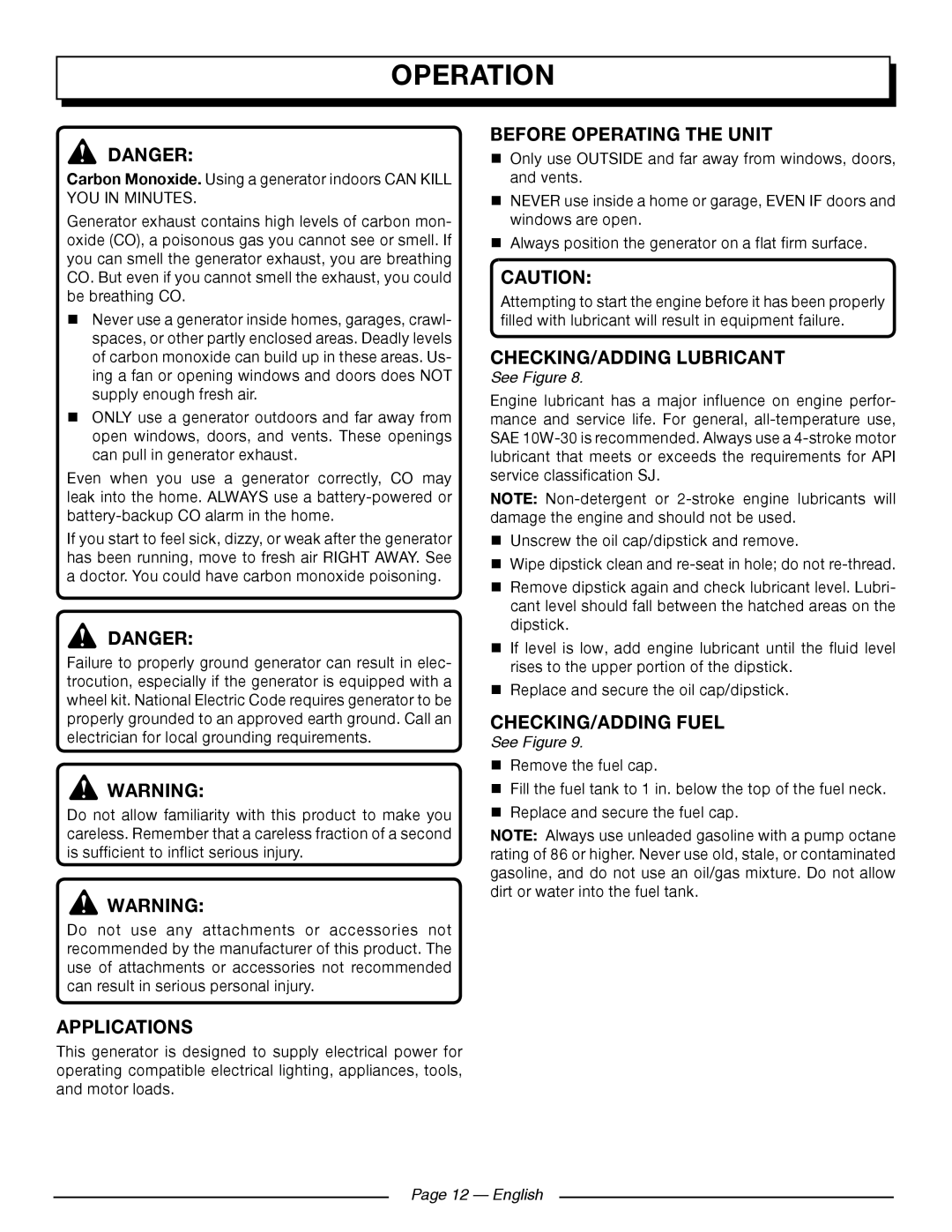
OPERATION
DANGER:
Carbon Monoxide. Using a generator indoors CAN KILL YOU IN MINUTES.
Generator exhaust contains high levels of carbon mon- oxide (CO), a poisonous gas you cannot see or smell. If you can smell the generator exhaust, you are breathing CO. But even if you cannot smell the exhaust, you could be breathing CO.
Never use a generator inside homes, garages, crawl- spaces, or other partly enclosed areas. Deadly levels of carbon monoxide can build up in these areas. Us- ing a fan or opening windows and doors does NOT supply enough fresh air.
ONLY use a generator outdoors and far away from open windows, doors, and vents. These openings can pull in generator exhaust.
Even when you use a generator correctly, CO may leak into the home. ALWAYS use a
If you start to feel sick, dizzy, or weak after the generator has been running, move to fresh air RIGHT AWAY. See a doctor. You could have carbon monoxide poisoning.
DANGER:
Failure to properly ground generator can result in elec- trocution, especially if the generator is equipped with a wheel kit. National Electric Code requires generator to be properly grounded to an approved earth ground. Call an electrician for local grounding requirements.
![]() WARNING:
WARNING:
Do not allow familiarity with this product to make you careless. Remember that a careless fraction of a second is sufficient to inflict serious injury.
![]() WARNING:
WARNING:
Do not use any attachments or accessories not recommended by the manufacturer of this product. The use of attachments or accessories not recommended can result in serious personal injury.
APPLICATIONS
This generator is designed to supply electrical power for operating compatible electrical lighting, appliances, tools, and motor loads.
BEFORE OPERATING THE UNIT
Only use OUTSIDE and far away from windows, doors, and vents.
NEVER use inside a home or garage, EVEN IF doors and windows are open.
Always position the generator on a flat firm surface.
CAUTION:
Attempting to start the engine before it has been properly filled with lubricant will result in equipment failure.
CHECKING/ADDING LUBRICANT
See Figure 8.
Engine lubricant has a major influence on engine perfor- mance and service life. For general,
NOTE:
Unscrew the oil cap/dipstick and remove.
Wipe dipstick clean and
Remove dipstick again and check lubricant level. Lubri- cant level should fall between the hatched areas on the dipstick.
If level is low, add engine lubricant until the fluid level rises to the upper portion of the dipstick.
Replace and secure the oil cap/dipstick.
CHECKING/ADDING FUEL
See Figure 9.
Remove the fuel cap.
Fill the fuel tank to 1 in. below the top of the fuel neck.
Replace and secure the fuel cap.
NOTE: Always use unleaded gasoline with a pump octane rating of 86 or higher. Never use old, stale, or contaminated gasoline, and do not use an oil/gas mixture. Do not allow dirt or water into the fuel tank.
Page 12 — English
